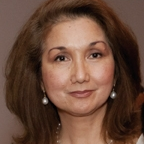SUMMARY
This is AI generated summarization, which may have errors. For context, always refer to the full article.
 Oh no, not again. But shocking? Naahhh.
Oh no, not again. But shocking? Naahhh.
That’s what I thought when Sheldon Jin, aka the actor Archie Kao, ended dead with lead in the head in the season finale of the fairly exciting NBC police drama Chicago PD.
If you’re like me, you look for shows produced, directed, written and/or starring Asians. Why not? We are part of the American fabric, and in the retelling of the “American” story, we should be included.
No one wants to be outside looking in, right? So seeing our experience played out to the world if not played by those who resemble us affirms our identity.
In each of the 18 episodes, Jin snagged more face time than the last, boding well for the former cast of CSI.

Forget that Kao’s character on Chicago PD was stereotypically “Asian,” Jin having been the tech ace on the special team of vice cops who manage to be endearing despite breaking all the rules.
Jin was smart and loyal but ratted on his guys to Internal Affairs to spare his father, a gambling addict, from deportation.
Family first: Asian trait allright.
Jin was the solo visible Asian in the mock police station set in the Windy City, which lists 148,000 or 5.5 percent of its population in the 2010 US Census as single-race Asian.
(Filipinos, by the way, outnumber their Asian cousins in Carl Sandburg’s City of Broad Shoulders, at 29,664, according to USA.com, few hundred shy of East Indians – or as they call themselves in California – South Asians, at 29,948, the most populous from the largest continent.)
Strange seeing the lonely Jew navigate a sea of white with dashes of black.
But there he was, giving new meaning to “Charity begins at home,” and paying the ultimate price for it.
As the hit series debut season drew to a close, Jew’s stunned buddies – 4 Caucasians including one woman, one Latino, one African American – contemplated the rubout.
NBC had no problem rehashing the idea for its brand-new psych thriller The Black List.
Was I elated to find early on not one but two Asian women in strong un-cliché roles in the series exploring the relationship of a global criminal brainiac and the always one step-behind CIA?
The series had just begun when one of the Asian – one of two aides of color (the other a black male) to the James Spader character, the brilliant but amoral – has her brains splattered on an indestructible cage that prevents “Red’s” foe du jour from reaching his prey.
Remember the other Asian female in the cast?
Well Meera Malik was of Indian or South Asian descent, like her alterego actor Parminder Nagra, who hit the big time in Bend it like Beckham followed by stints on “ER.” With a British accent, the perfect analyst, right?
TV tells us people who speak like Queen Elizabeth II or her colonial subjects overpopulate the United States – sitcoms, drama, news and talk shows, reality programs – even commercials, for crying out loud.
Best way to win fans across the Pond and mollify Asians in one fell swoop?
For a few weeks, tops.
Because while tracking a terrorist in a nightclub pulsating with techno blasts and blinking lights, no one notices when a fist reaches from behind to slice Malik’s throat.
Similar fate met Hetienne Park or investigator Beverly Katz, dissected in the final episode of the second season of Hannibal.
Why is it so easy for mainstream networks – or is it just NBC – to kill off Asians? And of all times in May, Asian American Heritage – just happens to be the end of regular programming season.
A long long time ago, programming “played to Peoria,” meaning shows should appeal to the nation’s heartland where Nielsen ratings count most.
But don’t CMOs know that Asians are the fastest growing demographic in the country?
“Out of the total US population, 14.7 million people, or 4.8 percent, were Asian alone. In addition, 2.6 million people, or another 0.9 percent, reported Asian in combination with one or more other races. Together, these two groups totaled 17.3 million people. Thus, 5.6% of all people in the United States identified as Asian, either alone or in combination with one or more other races,” said a 2012 report by the US Census Bureau.
Fortunately Asians enjoy bigger but still all-too-brief exposure in sitcoms.
Pat Morita’s Mr. T and Tina in 1976 and Margaret Cho’s All-American Girl in 1994, both on ABC, were the first network shows to focus on multigenerational Asian Americans, short-lived but dauntlessly visionary.
Rob Schneider’s eponymous Rob on CBS focused on his Mexican American in-laws while glossing over Schneider’s heritage.
The Saturday Night Live alum grabs every chance to disclose he is Filipino (a quarter, actually, his mom being half-Filipina, but no one’s divvying up Filipinoness here.) Add Vanessa Lachey to a rare Fil-Am on a sitcom, the forgettable Dads on Fox.
Coming up is Fresh off the Boat, also on ABC, written by Eddie Huang, who describes himself as “Taiwanese-Chinese-American” but “never American.”
Huang was born in Washington, DC to immigrant parents. He makes no apologies for his show’s title because it represents his personal family experience, he said.
Unfortunately the term turns off many Asians who consider it a slur and may cause its early demise.
In which case should Asian Americans be satisfied seeing brief representations of themselves in plum network dramas that end with their spectacular execution?
That would be tragic because dramas are the fount of industry accolades therefore professional success.
How can Asians on network TV rise to the stature of Denzel Washington, whose work on NBC’s St. Elsewhere sported the promise of a couple Oscars, if the bamboo ceiling kills them so soon?
Will it take an Asian American network chief to invest in Asian American talent having discerned a gold mine in Asian Americans?
Or should we concede that only in a 50th-state based drama will we find ourselves reflected almost accurately, diversely, in all our positive and less-so glory?
Think Hawaii Five-0.
Where Asian Americans number half of the population, we have cops, perps and vics, surfer dudes and working folk of every Asian background in various scenes on this CBS hit, so we can ignore that a hunky Aussie plays the formidable Steve McGarrett.
But there’s Darren Criss or Blaine Anderson on Fox musical Glee, and even I had no idea he was Filipino until I accidentally walked into his 2010 press conference in Makati. Maybe that’s it: Filipino diversity perplexes networks that know little of Philippine and Fil-Am history beyond what sells gossip rags and sites.
Now Glee is non-drama, unlike Grimm, the only major network program I know that stars a Fil-Am, Reggie Lee, who was born Reggie Valdez in Quezon City.
Interestingly he chose his screen name because he was getting lots of offers to play “Hispanic” roles, he said, and he doesn’t “even look Hispanic.” So what does he play on the horror drama? Sergeant Wu.
NBC, please don’t murder him. – Rappler.com
Cherie Querol Moreno identifies as a Filipino American, two cultures in one and not two halves of one. She is a commissioner with the San Mateo County Commission on Aging appointed to advise the County Board of Supervisors on issues affecting older Americans. She is founder and executive director of ALLICE Kumares & Kumpares, an all-volunteer nonprofit staging free violence prevention presentations in the community. A longtime journalist, she is executive editor of Philippine News. Rappler is publishing this essay with her permission.
Add a comment
How does this make you feel?
There are no comments yet. Add your comment to start the conversation.